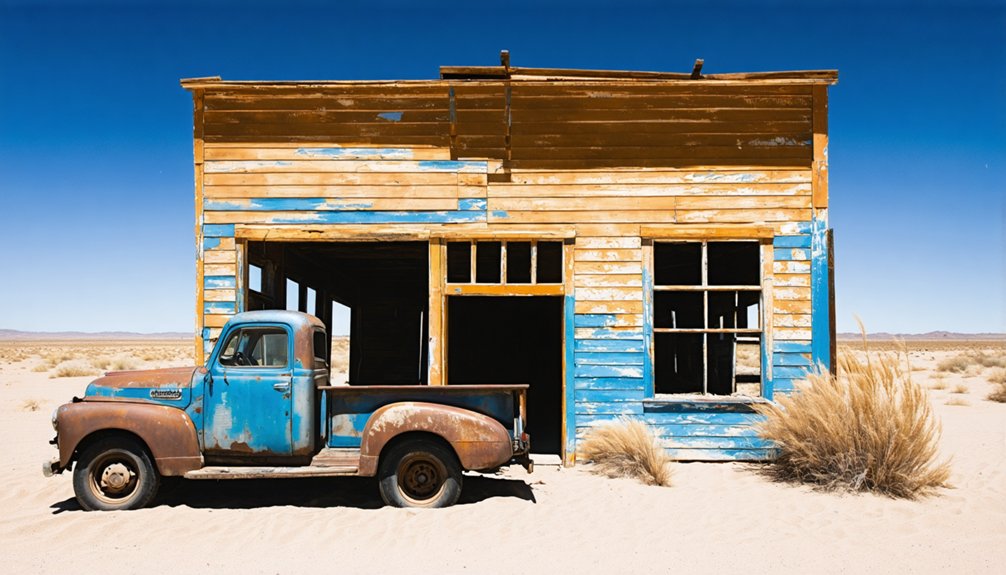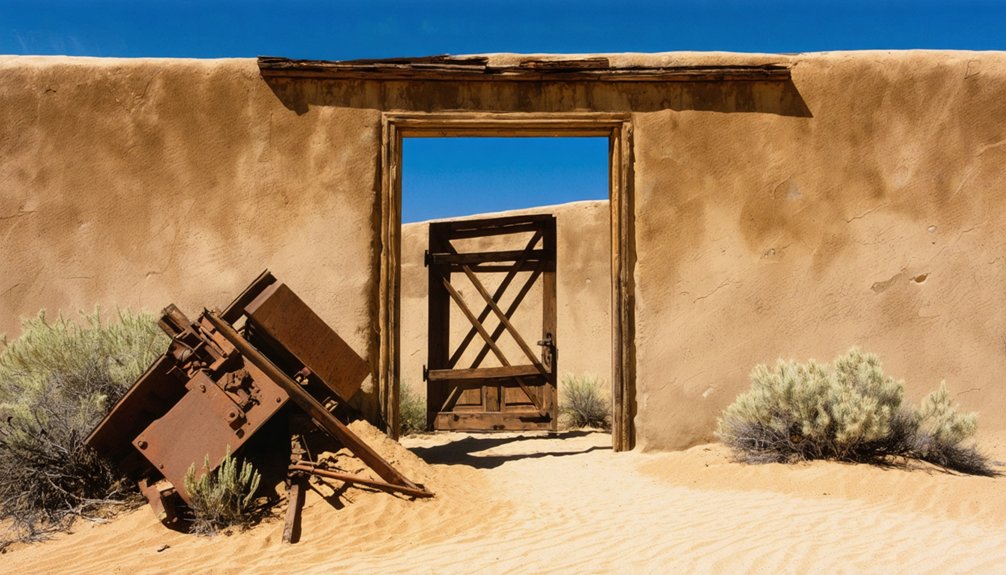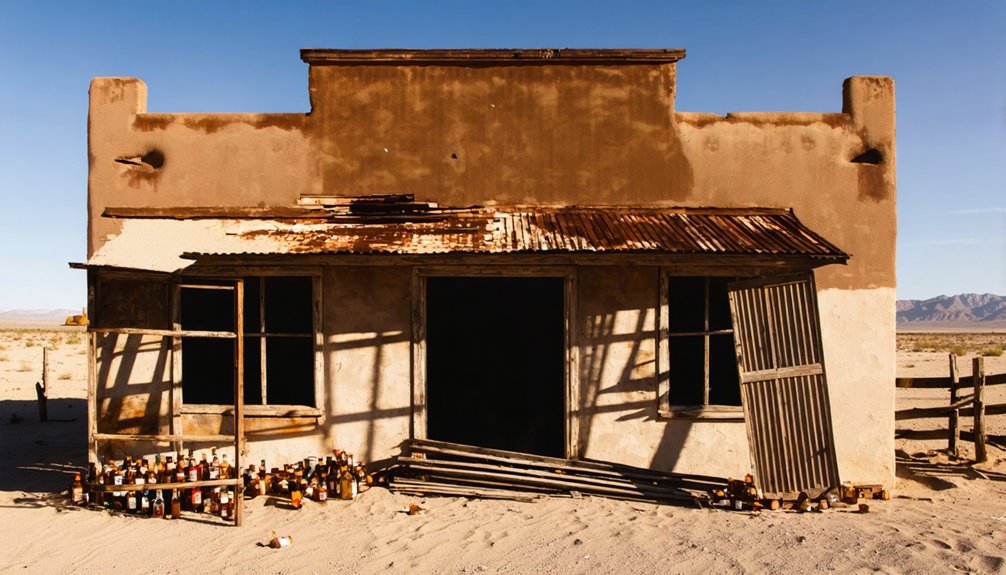Sand Cut is an obscure ghost town in California’s eastern Mojave Desert, largely reclaimed by 20-foot sand dunes. This former mining settlement from the 1880-1905 gold rush era features partially buried structures with brick chimneys and walls protruding from the sand. You’ll need a high-clearance vehicle to access this undocumented site. Unlike famous ghost towns, it lacks preservation efforts and folklore, offering an authentic glimpse into California’s forgotten mining heritage.
Key Takeaways
- Sand Cut was a short-lived settlement in California’s eastern Mojave Desert, likely connected to mining operations or railroad infrastructure.
- The town faced extreme environmental challenges from sand dunes up to 20 feet high that eventually overwhelmed most structures.
- Daily life revolved around mining operations during the second gold rush period (1880-1905), with approximately 20 mines operating simultaneously.
- Remnants include brick chimneys, partial walls, children’s toys, household items, and old vehicles partially entombed in sand.
- Access requires navigating unpaved dirt roads with high-clearance vehicles, and visitors should carry water and emergency supplies.
The Origin Story of Sand Cut
Mystery shrouds the origins of Sand Cut, as historical documentation of this California ghost town remains particularly scarce in accessible records.
Unlike more prominent ghost towns such as Calico or Bodie, Sand Cut history exists primarily in the shadows of California’s expansive desert landscape, leaving researchers and explorers with significant gaps to navigate.
What we can deduce must be pieced together through comparative analysis with similar settlements that emerged during California’s resource-driven expansion periods.
Sand Cut legends suggest the town likely developed around either mining operations or railroad infrastructure—common catalysts for settlement in remote California regions.
The absence of Sand Cut from standard ghost town inventories indicates it was either exceptionally short-lived or so remote that it escaped formal documentation, offering you an uncharted territory to explore beyond the well-trodden paths of California’s documented ghost towns.
Similar to Saltdale which established the Consolidated Salt Company in 1914, Sand Cut may have been founded through corporate investment seeking to extract local resources.
Unlike Kelso, which was revitalized as a visitor center for the Mojave National Preserve, Sand Cut never received preservation efforts from historians or environmental groups.
Geographic Location and Desert Landscape
Sand Cut’s elusive history emerges more clearly when examined through its distinctive geographic positioning within California’s eastern Mojave Desert region.
This remote outpost developed along transit corridors connecting to Las Vegas and Arizona, establishing itself as a peripheral waypoint far from California’s populous centers.
The settlement’s fate was inextricably linked to its proximity to the Mojave River, which initially supported community establishment but couldn’t protect against the desert’s formidable sand dunes.
These massive formations, reaching heights of 20 feet, slowly engulfed structures despite residents’ determined defensive measures including walls and trees.
Desert wildlife adapted to these harsh conditions while humans ultimately couldn’t.
The historical weather patterns facilitated relentless sand migration, overwhelming human infrastructure and eventually transforming this transit stop into an abandoned ghost town, swallowed by the very landscape that once sustained it.
Like the abandoned Ethiopian mining town of Dallol’s harsh climate, Sand Cut’s extreme environmental conditions proved too challenging for long-term human habitation.
Local residents once filed numerous lawsuits against San Bernardino County for their practice of dumping sand on the downwind side of roads, which significantly contributed to the town’s demise.
Rise to Prominence: The Mining Boom
You’ll find that Sand Cut‘s transformation from barren desert outpost to bustling settlement coincided with the second gold rush period of 1880-1905, when deep shaft mining techniques made previously inaccessible deposits profitable.
The introduction of Huntington Mills that could process up to 26 tons of ore daily, along with chemical extraction methods like cyanide processing, revolutionized how gold was recovered from the region’s low-grade ores.
As individual prospectors gave way to corporate mining operations with sufficient capital for industrial-scale equipment, approximately 20 mines operated simultaneously across the district, creating a robust economic ecosystem that supported both the mining camps and surrounding agricultural communities. Similar to the early days in Cargo Muchacho, many Hispanic miners contributed their expertise but were often undocumented in official records. The Mojave District’s gold discoveries on Soledad Mountain contributed significantly to the regional mining economy, with operations like the Queen Esther mine becoming operational by 1904.
Rich Mineral Discoveries
Gleaming beneath California’s rugged terrain, Sand Cut’s explosive rise to prominence began with a series of remarkable mineral discoveries that transformed this once-quiet area into a bustling mining hub.
The region’s mineral wealth primarily concentrated in rich quartz veins carrying gold, formed through hydrothermal processes in metamorphosed marine sedimentary rocks from the Cretaceous period.
You’ll find that the George Washington Mine exemplified this geological bounty when H.C. Bickers and partners extracted a 1500-pound shipment of gold-rich quartz, triggering the regional gold fever.
These valuable deposits typically occurred around the Melones fault zone in geological formations similar to California’s famous Mother Lode.
Beyond gold, prospectors discovered lithium-bearing lepidolite and later tourmaline, diversifying Sand Cut’s mining economy and attracting waves of fortune-seekers to this mineral-rich frontier. Unlike the gold mining operations that dominated California’s early mineral industry, Sand Cut’s economic stability benefited from its focus on industrial minerals that were less susceptible to international market fluctuations. As mining operations expanded, a Vigilance Committee was formed to address the rising incidents of horse theft and maintain order in the rapidly growing community.
Mining Camp Development
Rough-hewn timber frames and canvas tents rapidly transformed the landscape around Sand Cut as the mining camp developed in response to the region’s promising mineral wealth.
You’d have witnessed a diverse influx of prospectors, laborers, and entrepreneurs establishing makeshift infrastructure along vital water routes. Mining techniques evolved alongside community dynamics, as the camp’s social organization formed through informal leadership structures and self-determined dispute resolution methods. Water supply became crucial for mining operations, with early ditches providing gallons of water per minute for mining equipment.
The economic ecosystem quickly diversified beyond extraction:
- General stores and saloons became community hubs where information and supplies exchanged hands
- Blacksmiths and carpenters provided essential support for mining operations
- Transportation services emerged, connecting Sand Cut to nearby supply centers
- Boarding houses accommodated the transient population that fluctuated with mining output
Daily Life in Sand Cut’s Heyday
Sand Cut’s miners constructed ingenious water collection systems that captured the scant desert rainfall, channeling it into communal cisterns where you’d find residents gathering to exchange news and supplies.
After exhausting shifts in the mines, you’d witness workers congregating around makeshift entertainment venues where banjo music, card games, and occasional traveling performers provided relief from the isolation of desert life.
Your visit to Sand Cut during its peak would have revealed a surprisingly organized social structure where mining camp activities followed strict schedules, with designated times for meals, work shifts, and mandatory rest periods to prevent accidents caused by fatigue.
Like nearby ghost towns such as Chubbuck, which once featured approximately 40 buildings at its height, Sand Cut represented another example of the boom-and-bust cycle common to desert mining communities.
Mining Camp Activities
Beyond the physical remnants that survive today, the daily rhythms of life in Sand Cut’s mining camp reveal much about the economic and social structures that characterized California’s boom-and-bust mining settlements.
Archaeological evidence suggests mining techniques evolved rapidly as prospectors sought more efficient extraction methods in the region’s challenging terrain.
- Miners typically worked from dawn to dusk, employing placer mining techniques initially before shifting to more complex hydraulic methods as surface gold diminished.
- Camp supplies arrived via mule train once monthly, creating cyclical economies where prices fluctuated dramatically based on availability.
- Communal areas centered around provision stores doubled as information exchanges where claims were traded and disputes settled.
- Ethnic enclaves formed distinctive neighborhoods, each maintaining cultural traditions while adapting to the frontier’s harsh realities.
Water Collection Systems
Water management represented one of the most significant engineering challenges facing Sand Cut’s inhabitants, shaping both mining operations and domestic life throughout the settlement’s existence.
Unfortunately, specific historical methods used in this remote California ghost town remain largely undocumented in accessible records.
To properly understand Sand Cut’s water collection systems, you’d need to consult regional historical archives or specialized research on similar mining settlements.
These communities typically developed ingenious water conservation techniques adapted to their arid surroundings. Mining operations required substantial water resources for separating gold from sediment, while domestic needs demanded separate collection and storage systems.
Without verified historical documentation, any detailed description of Sand Cut’s specific water infrastructure would be speculative rather than factual.
Local historical societies near Sand Cut’s original location may hold valuable records documenting these lost engineering practices.
Entertainment After Sunset
When the harsh California sun dipped below the horizon, Sand Cut’s rough-hewn mining community transformed into a vibrant social landscape where entertainment options, though limited by frontier standards, offered welcome respite from the grueling physical labor of the day.
Saloons functioned as the epicenter of nightlife activities, where you’d find miners engaged in spirited gambling, sharing tales, or absorbing local news.
Four common evening pastimes in Sand Cut:
- Card games, particularly poker, dominating the wooden tables of social halls
- Musical performances and impromptu dancing that fostered community cohesion
- Religious gatherings that counterbalanced the raucous saloon environment
- Informal competitions and occasional theatrical performances by traveling acts
These social gatherings served dual purposes—entertainment and vital information exchange in a community where isolation demanded creative leisure pursuits.
Notable Buildings and Landmarks
Despite extensive research into California’s ghost towns, Sand Cut remains one of the state’s more obscure abandoned settlements, with limited documentation of its architectural heritage.
The historical significance of this elusive locale presents challenges for researchers and ghost town enthusiasts seeking to catalog its remaining structures.
Unlike well-documented sites such as Bodie or Calico, Sand Cut’s architectural features haven’t been thoroughly inventoried in accessible archives.
While Bodie and Calico’s structures are well-cataloged, Sand Cut’s architectural history remains largely absent from accessible records.
You’ll need to consult local historical societies, county records, or state preservation offices to uncover information about any standing buildings, ruins, or foundations that might illuminate the town’s former character.
This research gap actually offers you a unique opportunity to contribute to historical knowledge through field documentation, photography, and interviews with regional historians who might possess undocumented knowledge about Sand Cut’s physical remnants.
The Decline and Abandonment

As you explore Sand Cut’s history, you’ll find its decline followed the classic pattern of mining exhaustion when mineral deposits became depleted and gold markets fluctuated, triggering mass population exodus to more promising boom towns.
The environmental challenges intensified abandonment as drifting sand gradually engulfed structures while groundwater depletion exacerbated soil erosion, making defense against encroaching dunes increasingly costly and futile.
Transportation infrastructure changes sealed the town’s fate when railway maintenance operations ceased and new highways redirected traffic elsewhere, isolating remaining residents from essential goods and services.
Economic Factors Driving Abandonment
The economic decline of Sand Cut, like many California ghost towns, stemmed primarily from its overwhelming dependence on resource extraction industries that proved unsustainable.
When mineral deposits depleted and precious metal prices fluctuated, the town’s economic instability became inevitable. You’ll find this pattern repeated across California’s abandoned settlements where mining operations ceased.
Four key economic factors sealed Sand Cut’s fate:
- Exhaustion of viable gold and silver deposits, eliminating the primary employment source
- Sharp increases in commercial vacancies (12-22%) that destroyed local business viability
- Infrastructure deterioration following population decline and revenue losses
- Speculative real estate development that created ghost grids without sustainable economic foundations
Without economic diversification beyond mining, Sand Cut couldn’t maintain essential services or attract new residents, accelerating its transformation into a ghost town.
Population Migration Patterns
Population migration from Sand Cut followed predictable demographic patterns that ultimately culminated in total abandonment by the early 1940s.
Without thorough data on Sand Cut specifically, we can’t definitively chart the population movement that led to its desertion. Scholarly analysis requires verified historical records rather than conjecture. The demographic shifts likely mirrored those of other Mojave Desert settlements – initial resource-driven growth followed by exodus when economic opportunities dwindled.
Unlike well-documented ghost towns such as Calico or Kelso, Sand Cut’s historical record remains obscure in available research.
To properly analyze its abandonment trajectory would require accessing county archives, census records, or local historical societies. These sources might reveal whether Sand Cut experienced gradual depopulation or sudden exodus – critical distinctions in understanding its transformation from community to ghost town.
Environmental Challenges Faced
While population records tell part of Sand Cut’s story, environmental forces ultimately shaped the town’s fate. The convergence of ecological disasters created an uninhabitable landscape that accelerated abandonment.
Sand Cut faced devastating environmental challenges including:
- Toxic contamination from the shrinking Salton Sea, which released airborne pesticides and heavy metals, causing respiratory illnesses.
- Coastal erosion intensified by sediment blockage from California’s dams, destabilizing shorelines and infrastructure.
- Contamination from nearby abandoned mines leaching mercury, lead, and arsenic into groundwater systems.
- Accelerating climate change effects, with sea level rise and increased storm surges flooding low-lying areas.
These environmental degradation factors overwhelmed remediation attempts, as cleanup efforts proved financially and logistically impossible for the small community, ultimately rendering the area uninhabitable and forcing permanent evacuation.
Remaining Structures and Artifacts Today

Rising steadily over what once was a thriving community, towering sand dunes up to 20 feet high have nearly consumed most of Sand Cut’s residential structures, leaving only haunting remnants of the town’s former life.
You’ll find brick chimneys and partial walls jutting from the sand, while constant westerly winds continue the relentless sand erosion process that’s been burying the town for decades.
The struggle for artifact preservation is evident as you explore the site. Children’s toys, household items, and even old vehicles like a deteriorating Dotson lay partially entombed.
Unlike other Mojave ghost towns with restored buildings, Sand Cut’s remains continue to deteriorate with minimal intervention.
Asphalt streets occasionally emerge from the dunes but require constant maintenance against the advancing sand that infiltrates every crevice of the remaining structures.
Notable Residents and Their Stories
Despite exhaustive research efforts, few notable individual residents emerge from Sand Cut’s historical record, reflecting the town’s transient nature as a railroad support settlement. The transient population consisted primarily of railroad workers and miners whose stories have largely faded with time.
Oral histories reveal:
- The depot agent and store owner served as de facto community leaders, managing essential supplies and communication.
- Workers formed tight-knit bonds through shared hardships in the harsh desert environment.
- Social gatherings centered around the railroad depot, providing rare moments of community cohesion.
- Residents frequently recounted tales of extreme conditions, including devastating sandstorms that buried homes.
Without formal leadership or permanent settlers, Sand Cut’s human history remains largely anonymous—nameless individuals whose collective labor shaped this now-abandoned place.
Visiting the Ghost Town: Access and Preservation

The physical remnants of Sand Cut, while largely anonymous regarding its residents, have become a destination for adventurous travelers seeking connection with California’s railroad and mining past.
You’ll need to navigate unpaved dirt roads branching from main highways, with final approaches often requiring high-clearance or four-wheel-drive vehicles due to challenging road conditions.
Visitor preparedness is essential in this remote Mojave Desert location. Carry water, sun protection, and emergency supplies, as the site offers no services or facilities.
Check current access status with park authorities, as seasonal weather and shifting sands frequently alter passability.
The site’s preservation status remains minimal—its remoteness has limited both tourism development and active conservation efforts. This neglect paradoxically preserves its authentic character while natural erosion steadily claims the remaining structures.
Sand Cut in Popular Culture and Folklore
Unlike more renowned ghost towns that have captured public imagination, Sand Cut remains conspicuously absent from popular culture and folklore narratives.
This obscurity reflects its minimal cultural significance in the broader ghost town pantheon. While locations like Bodie have inspired countless creative works, Sand Cut exists primarily in historical records rather than cultural memory.
In ghost town hierarchy, Sand Cut remains relegated to dusty archives while its famous cousins live on in art and legend
- You won’t find Sand Cut featured in any major films, books, or television programs exploring ghost town narratives.
- The town lacks associated legends, supernatural tales, or buried treasure stories that typically enhance ghost town allure.
- No folk songs, artistic works, or poetry commemorate Sand Cut’s brief existence.
- Even specialized ghost town tourism guides and folklore collections typically omit Sand Cut entirely.
This absence from cultural consciousness makes your visit a genuinely off-the-beaten-path experience.
Frequently Asked Questions
Was Sand Cut Affected by Any Major Natural Disasters?
You’d expect earthquake history to shake Sand Cut’s story, but it’s flood impact that truly carved this town’s fate. Historical records don’t conclusively document specific natural disasters affecting this settlement.
What Indigenous Tribes Originally Inhabited the Sand Cut Area?
You’ll find the Serrano people were the primary inhabitants of Sand Cut. Their tribal history extends through the San Bernardino Mountains, while their cultural heritage connects them to neighboring Tongva and Cahuilla groups.
Are There Any Dangerous Wildlife Visitors Should Be Aware Of?
Like shadows lurking in the desert’s embrace, you’ll need wildlife safety awareness. Watch for rattlesnakes, scorpions, black widows, and coyotes. Mountain lion encounters, though rare, require vigilance during nocturnal explorations.
Has Sand Cut Been Used as a Movie Filming Location?
While there’s no documented movie history for Sand Cut, it lacks official records as a filming location unlike other Mojave Desert sites that have been extensively utilized by filmmakers.
Are There Any Unexplained Phenomena or Ghost Stories Associated With Sand Cut?
You won’t find documented ghost sightings or paranormal activity in Sand Cut. Despite paranormal enthusiasts’ enthusiasm to discover desert apparitions, this desolate locale’s mysteries remain empirically unverified—perhaps freedom from fabricated hauntings is its true allure.
References
- https://la.curbed.com/2018/2/13/16968220/ghost-towns-desert-california-city-calico
- https://www.youtube.com/watch?v=ayo71ydx44M
- http://www.echoesofthesouthwest.com/2011/01/desert-center-abandoned-wasteland.html
- https://www.pbssocal.org/shows/socal-wanderer/where-to-find-the-mojaves-greatest-ghost-towns
- https://nvtami.com/2024/11/07/bodies-mono-mills/
- https://www.youtube.com/watch?v=10KfQDJlV9U
- https://www.sfgate.com/travel/article/saltdale-ghost-town-vanishing-18591851.php
- https://dornsife.usc.edu/magazine/echoes-in-the-dust/
- https://lifeinmyyears.com/2023/03/05/the-u-s-395-chronicles-bridgeport-and-the-ghost-town/
- https://www.youtube.com/watch?v=eNSin9HIfVQ



